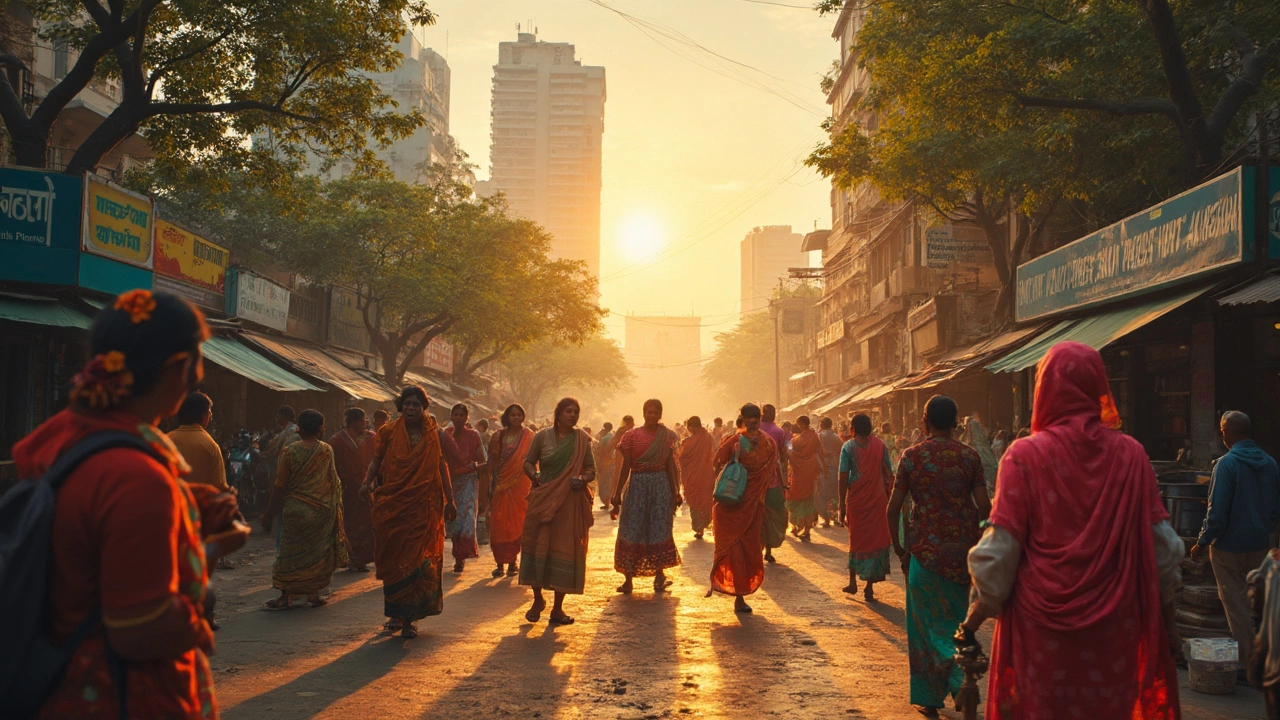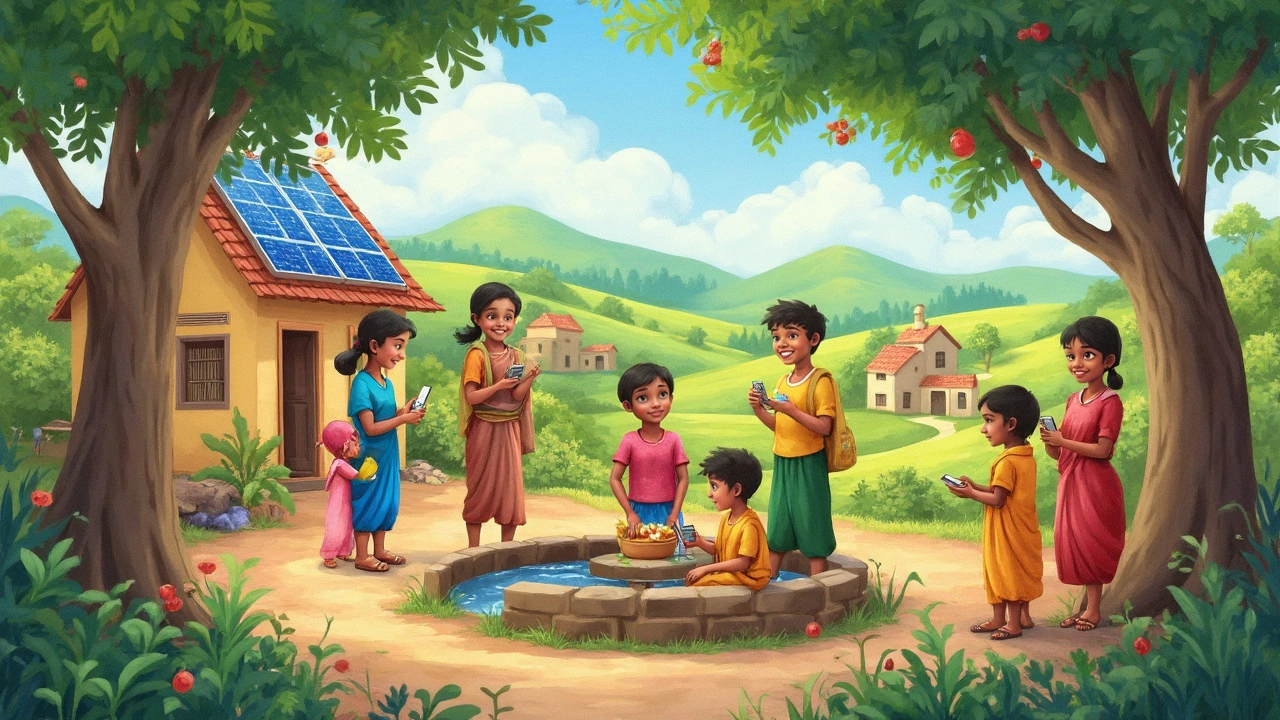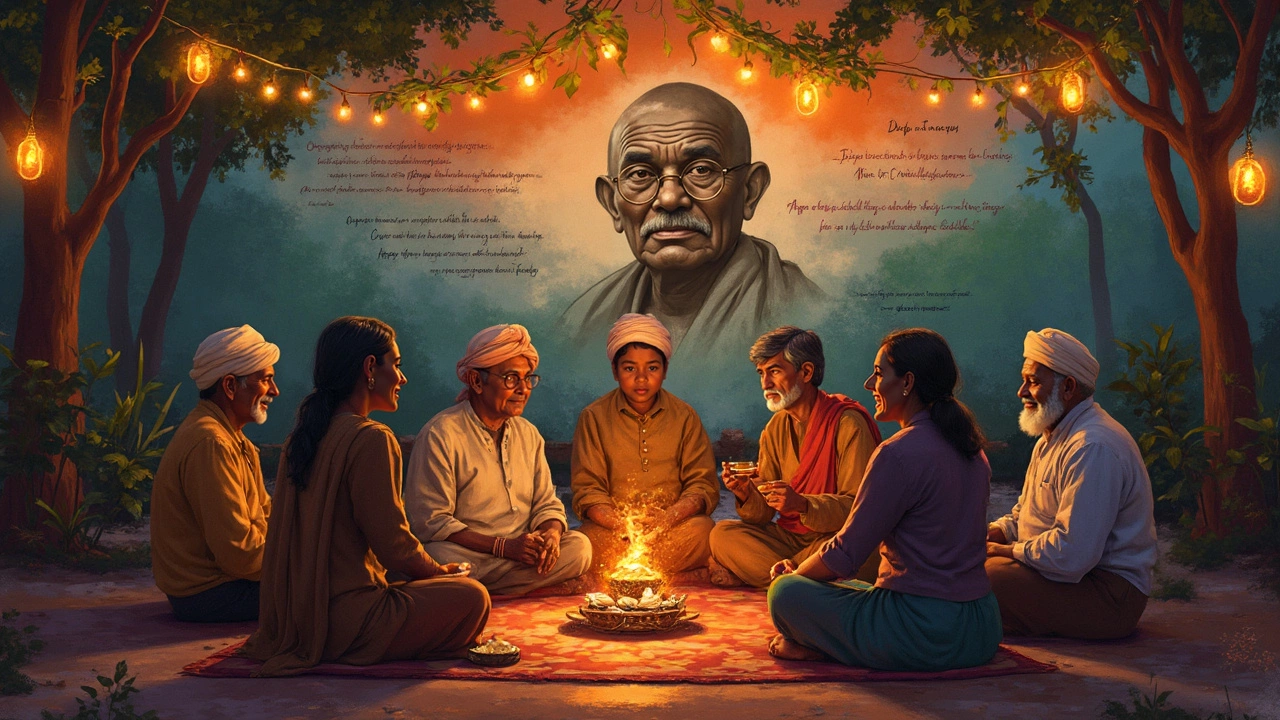Ideal India Vision: Life Quotes and Everyday Wisdom
 May, 2 2025
May, 2 2025
Imagine walking down a street in India without worrying about safety, pollution, or whether your neighbor will help you out when you need it. That’s where the idea of an ideal India really starts: the basics. People need clean water, decent jobs, and reliable healthcare—real stuff families talk about at dinner. We can’t keep dreaming about a perfect future unless we nail down these essentials first.
It’s not a wild or unreachable goal. Just look at Kerala’s healthcare statistics or how many small towns are now getting Wi-Fi. These aren't just headlines; they're examples of how steady, practical progress works. If you want India to shine, start with asking, “What do people actually need each day?” Once those basics are reliable, everything else—education, safety, chances to chase your dreams—feels possible. Setting that vision isn’t just up to leaders; it’s about what normal folks want for their everyday life.
- A Vision Rooted in Everyday Needs
- Unity in Diversity: Learning from Each Other
- Wisdom from Life Quotes
- What Holds Us Back?
- Small Changes, Big Impact: How You Can Help
A Vision Rooted in Everyday Needs
You can’t talk about an ideal India without addressing what actually matters most to people: everyday basics. Think clean water, enough food, working toilets, and comfy homes. Here’s a reality check—according to National Statistical Office data from 2023, about 35% of rural Indian households still don’t have piped drinking water. We see the numbers slowly dropping, but progress is a daily grind.
Healthcare often makes or breaks a family. While India has set up more than 1.5 lakh (150,000) health and wellness centers, gaps are everywhere—especially in remote places. Simple things like regular doctor visits or stocked clinics are still a dream for some. And you can’t ignore jobs—especially stable, decent work that pays well and treats people fairly. Last year, the unemployment rate hovered close to 7.5%, hitting young adults the hardest.
So what does a practical vision for an ideal India look like? It’s neighborhoods where every kid can go to school, meals on the table three times a day, and neighbors who aren’t afraid to lend a hand. No one should have to fight for hospital beds or clean air. These aren’t just big, fancy goals; they’re what any average family wants. Here’s what makes the biggest difference:
- Reliable water and power supply
- Easy access to affordable healthcare
- Good schools that don’t feel out of reach
- A safe neighborhood—no matter the time of day
- Steady jobs with fair wages
Check the facts in the table below to spot where things stand right now—progress is real, but so’s the gap between today and that ideal India we all imagine.
| Essential Need | % of Indian Households Covered (2023) |
|---|---|
| Piped Drinking Water | 65% |
| Electricity Access | 98% |
| Flush Toilets | 70% |
| Primary School Enrollment | 97% |
| Internet Access | 55% |
If you want to push for a better tomorrow, start by speaking up about these basic needs. Volunteer, share resources, and don’t just wait for government schemes. This is the backbone of any strong, progressive country—and the heart of a truly ideal India.
Unity in Diversity: Learning from Each Other
You hear the phrase "unity in diversity" all the time, but in ideal India, it’s more than just a slogan. This country has over 1,600 spoken languages, nearly every major religion, and food that can change completely every 100 kilometers. A lot of folks only realize how much we can learn from each other when they move from a small town to a big city or vice versa.
Look at how festivals are celebrated. Diwali might mean lighting diyas in North India, but down South, it’s about local sweets and early morning baths. Eid in Hyderabad comes with haleem, and in Kolkata, it’s about biryani and hugs across communities. People share these traditions at work and in schools, trying each other’s foods and wishing each other well, which builds real bonds.
Language is another interesting bit. According to the 2011 Census, less than half the population speaks Hindi as their first language, yet it's the glue in many workplaces and movies. Knowing even a few words in another language can help break the ice, whether you’re dealing with customers or making friends in college.
- Try learning basic greetings in more Indian languages—people appreciate the effort, and you might make friends for life.
- Attend festivals outside your own faith or region if you get the chance. Ask questions, listen, and enjoy without judging.
- Share your home recipes with friends from different backgrounds—food is hands-down the best connector.
The push to blend cultures goes beyond just being polite. When metro cities like Mumbai and Bengaluru welcome students and workers from everywhere, they often end up creating neighborhoods where South Indian, North Indian, North-Eastern, and others live side by side. Sure, sometimes there are hiccups, but more often, there’s sharing, helping, and teaming up. That’s real unity in diversity, showing how Indian values can make daily life smoother.
| Fact | Number |
|---|---|
| Number of official languages (per Eighth Schedule) | 22 |
| Total recognized mother tongues | 1,369 |
| Religions practiced (major) | 5+ |
Building a more ideal India doesn’t mean everyone has to be the same. It means respecting and actually seeing the people around you—not just as neighbors, but as teachers. If we want that easy, peaceful daily life, learning from each other is the most practical place to start.

Wisdom from Life Quotes
If you really want to get what an ideal India could look like, just listen to what everyday people and legendary leaders have said. These aren’t just pretty words for a calendar—they’re actual guides for living better and building the country everyone dreams of.
Take Dr. A.P.J. Abdul Kalam’s famous line: “Dream, dream, dream. Dreams transform into thoughts and thoughts result in action.” He meant it for students, but it makes sense for everyone. Your small steps—learning a skill, helping a neighbor, voting smart—can snowball into bigger change.
Mahatma Gandhi’s classic, “Be the change you wish to see in the world,” isn’t just a slogan on t-shirts. If you want an ideal India where honesty and fairness matter, it starts with your own choices, whether that’s standing in line or picking up litter instead of walking past it.
Want proof these quotes work? Studies show that positive messaging from leaders actually bumps up civic actions. According to a 2022 survey by Praja Foundation, youths who discuss such quotes with family or teachers are 25% more likely to join in neighborhood clean-up drives or local elections.
Here are a few practical ways to use these life quotes every day:
- Write down a quote you like on a sticky note. Stick it somewhere you’ll see it—fridge, desk, or even your phone’s home screen.
- When you hit a rough patch, repeat one of these quotes—loudly or just in your head. Turns out, self-reminders work (science backs it).
- Share a quote with friends or family who seem stuck. Sometimes it’s the boost that gets someone moving.
These small sparks from trusted quotes create ripples—at home, at work, on the street. Before you know it, those classic words start shaping real habits and, eventually, the future India you want.
What Holds Us Back?
When we talk about a truly ideal India, it’s easy to list what's missing or what sounds good on paper. But, the roadblocks are pretty real and practical. Let’s get into what’s actually holding us back.
Corruption is right up there. According to Transparency International’s 2024 Corruption Perceptions Index, India ranked 93rd out of 180 countries. That’s not where a country with big dreams wants to be. People still pay bribes to get stuff done—from a driver’s license to basic utilities. This slows everything down and makes it tough for honest folks.
Jobs are another sticking point. India needs more jobs that pay a fair wage, especially for the youth. A survey by CMIE in 2024 put unemployment at about 7.7 percent, but for young graduates it’s way higher. This isn’t just about numbers. If there are no good jobs, dreams take a backseat.
Education sounds great on posters, but there’s a big gap in quality. Kids in many government schools still don’t have proper toilets or safe drinking water. The Annual Status of Education Report (ASER) 2023 says only 43% of kids in Class 5 can read a Class 2-level text. This makes it tough to talk about a rising or future India.
Let’s not forget about bad infrastructure. Ever seen a broken road turn into a swimming pool during monsoon? That’s just a tiny part of the daily hassles people in both cities and villages face. Poor public transport, patchy internet, and blackouts don’t make life any easier.
Sometimes, we get stuck in old ways—caste bias, religious divides, and gender discrimination. These things don’t just slow us down, they divide us. The latest National Crime Records Bureau data from 2023 shows a steady rise in crimes against women and minority groups. If we want Indian values to mean something positive, these barriers need to go.
Here's a quick look at some of these issues:
| Issue | Current Fact/Stat |
|---|---|
| Corruption | India ranks #93/180 (Corruption Index 2024) |
| Youth Unemployment | Over 17% (CMIE, 2024) |
| Basic Reading Skills (Class 5) | 43% can read at Class 2 level (ASER 2023) |
| Crimes Against Women | Up 4% from last year (NCRB 2023) |
So, when you picture the vision of an ideal India, it’s not about ignoring these setbacks, but actually facing them straight up and figuring out how to fix them, one step at a time.

Small Changes, Big Impact: How You Can Help
Changing the whole country sounds massive, but the truth is, even tiny actions add up fast. The dream of an ideal India isn't built on just flashy moments; it's in the daily choices people make together.
Take waste segregation, for example. Indian cities generate about 62 million tons of solid waste every year. Yet, in Indore, the city turned itself around with simple habits—separating wet and dry waste, composting at home, and building a culture where tossing trash anywhere isn’t cool. Imagine if that mindset took hold everywhere.
- Support local businesses: Instead of heading for big chains, try buying from the small store around the corner. Every sale helps a family, not just a giant company.
- Conserve water at home: Sounds obvious, but fixing a leaking tap can save up to 5500 liters in a year in a single household, according to the Bureau of Indian Standards.
- Volunteer for community clean-ups: Groups like The Ugly Indian started with just five friends and now inspire volunteers all across cities. One hour a month with a few neighbors can transform neglected spots.
- Talk openly about education: Don’t just leave it to teachers. Share what you know, help a local kid with homework, or donate unused books.
- Use public transport or carpool: If just one in ten Indians took the metro or bus instead of driving, air quality would improve in every major city.
Here are a few more easy wins with a real impact:
| Action | Possible Impact |
|---|---|
| Planting a tree | Can absorb up to 21 kg of carbon dioxide yearly |
| Donating blood | One donation saves up to 3 lives |
| Teaching a skill online | Empowers those without access to regular classes |
| Recycling at home | Reduces waste sent to landfills by 17% on average |
You don’t have to wait for big policy changes. Sometimes, it’s just about being the person who smiles at a stranger, stands up for fairness, or fixes problems right where you live. Want an ideal India? Start with your street, your building, your friend circle. These small choices, stacked together, can literally change lives.